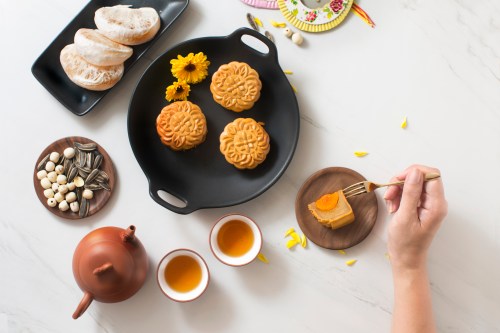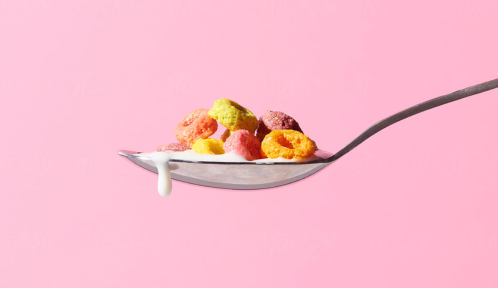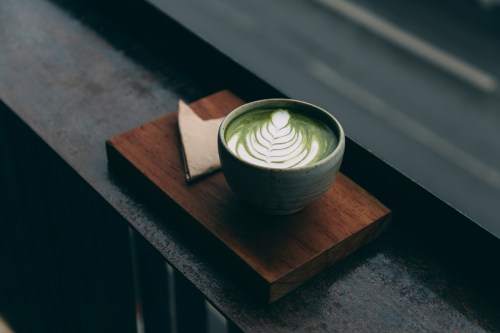Our editors independently select these products. Making a purchase through our links may earn Well+Good a commission
Just because January 1st has passed doesn’t mean the new year is over. For Chinese people (and many other East Asian communities), the new year, also known as Lunar New Year has just begun. Starting on February 12, the two-week celebration marks a time for new beginnings, prosperity, and good health. And in my family, there is no better way to ring in this holiday than with a Chinese mooncake.
Experts in This Article
Sarah Leung is the blogger of The Woks of Life.
Wei Guo is the recipe developer and photographer of Red House Spice
Mooncake is a Chinese delicacy filled with rich and sweet fillings—and many different regions have their own spin on the dish. “The most classic is the Cantonese one. Red bean paste filling and lotus seed fillings are the most popular,” says Wei Guo, recipe developer and photographer of Red House Spice, a food blog sharing Chinese recipes.
But this traditional cake stuffed with sweet filling is more than just a holiday staple. It has become the symbol of community, and its significance is rooted in its shape. “Despite the fact that the mooncake can take lots of different forms, they’re almost always round. The round circular shape represents family togetherness and reunion,” says Sarah Leung, of the Chinese food blog The Woks of Life.
As mentioned, my family and I eat Cantonese-style mooncakes during the Lunar New Year. But it is traditionally also eaten during the Mid-Autumn Festival, also known as the moon festival—which has been an annual celebration in China for thousands of years. Mooncakes became popular during the festival starting with the Yuen Dynasty in the late 1200s; since then, mooncakes have become an indispensable treat on every special occasion and are usually gifted or shared with loved ones.
Although mooncake is more commonly eaten during the Mid-Autumn festival, you can now enjoy it all year-round with Wei’s Cantonese mooncake with salted egg yolk recipe. A few cooking notes before we dive into the recipe: Wei uses grams instead of cups to measure out her dry ingredients, so you’ll need a food scale to make sure your measurements are precise. (You can also use an online gram-to-cup converter, but those aren’t always accurate.) You’ll also need a mooncake mold to help you shape the cakes, which you can find in Chinese markets or on Amazon.
This recipe uses lotus seed paste and salted egg yolk for the filling, which Wei says is a classic combination. There are instructions for making the lotus seed paste below; you may purchase ready-to-use salted egg yolks which come in airtight plastic bags at Chinese grocery stores. Alternatively, you can use raw salted duck eggs and cook the yolks yourself.
These delicious cakes are a lot of work, but in my family, they’re essential to celebrating the new year. Gung Hay Fat Choy (happy new year in Chinese)!
Chinese mooncake recipe
Makes 4-6 servings
Ingredients
For the lotus seed paste:
120 grams dried lotus seeds90 grams sugar70 grams sunflower oil
For the dough:
150 grams invert syrup (or golden syrup)50 grams sunflower oil1/2 tsp lye water220 grams all-purpose flourCornstarch, for dusting
For the egg wash:
1 egg yolk1 tsp water
20 salted egg yolks, for filling
1. To make the lotus seed paste, soak dried lotus seeds in water overnight. Drain and remove the green center (if any).
2. Boil the soaked seeds in fresh water (enough to cover) until soft (about 30-40 minutes). Drain, then puree in a food processor until smooth (add a little water if necessary).
3. Transfer the puree into a non-stick pan. Cook over medium heat. Add sugar and oil in batches. Stir and flip constantly. Once the paste becomes dry and holds in shape, remove to cool. (Any leftover paste not used can be frozen.)
4. Next, prepare the dough: Mix syrup, oil, and lye water until well incorporated. Add flour—the amount of flour needed will vary on the thickness of the syrup, so adjust accordingly. Knead briefly until combined.
5. Cover and rest for 30 minutes.
6. To assemble the cakes, put one egg yolk and some lotus seed paste on the scale. Adjust the filling to reach 30 grams.
7. Flatten the paste into a round thin circle. Place the egg yolk in the middle. Gently push the paste upwards to seal around the egg yolk completely.
8. Flatten 20 grams of the dough into a round circle. Place the filling ball in the center, and using the same method, gently push the dough upwards and around the filling to tightly wrap it and make a ball. (Your mooncakes should be about 50 grams each total.)
9. Coat the ball with a thin layer of cornstarch. Put it into a mooncake mold.
10. Place the mold on a baking tray (lined with parchment paper if necessary). Gently press to shape. Repeat for the remaining mooncakes.
11. To bake, preheat the oven to 375°F. Bake the cakes for five minutes.
12. Reduce the temperature to 320°F. Take the mooncakes out and brush the top with a thin layer of egg wash, removing excess liquid from your brush by pressing it on the rim of the bowl. Put back into the oven and bake further for five minutes.
13. Remove and brush with another layer of egg wash. Then continue to bake for 10 to 15 minutes until evenly brown.
14. Once completely cooled, store the mooncakes in an airtight container for at least one to two days. They are ready to be served when they become soft to touch and appear shiny.
15. You may keep them in the fridge for up to two weeks. Bring back to room temperature prior to serving.
Have you checked out The Well+Good SHOP? Our editors sift through hundreds of products every week so that you don’t have to—and now, you can find their faves (from skin care to self care and beyond) in one carefully curated space. What’re you waiting for? Get shopping!
Sign Up for Our Daily Newsletter
Get all the latest in wellness, trends, food, fitness, beauty, and more delivered right to your inbox.
Got it, you've been added to our email list.










